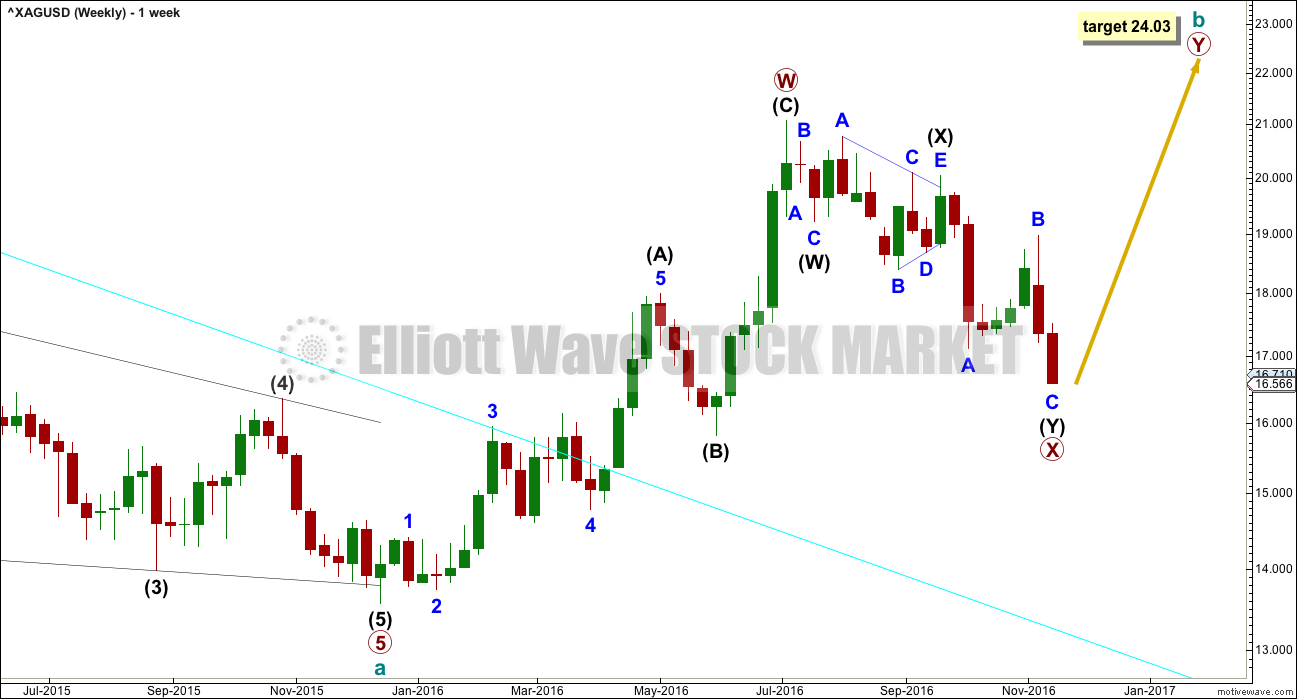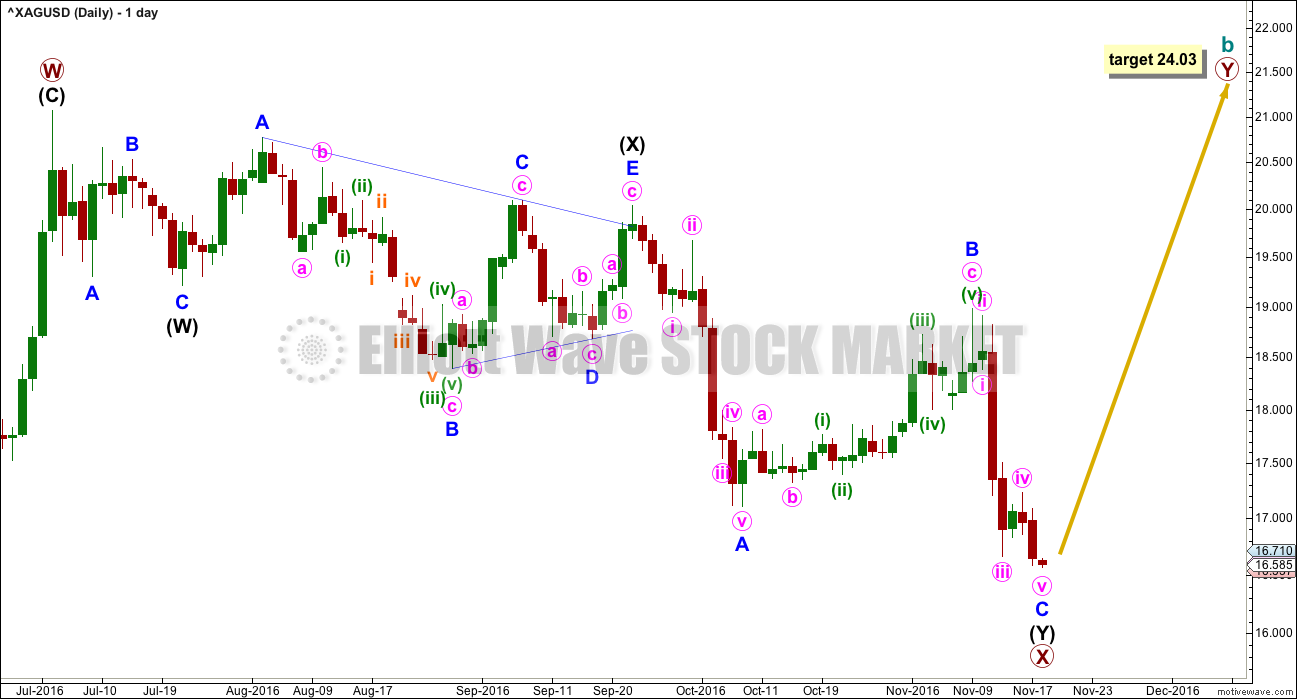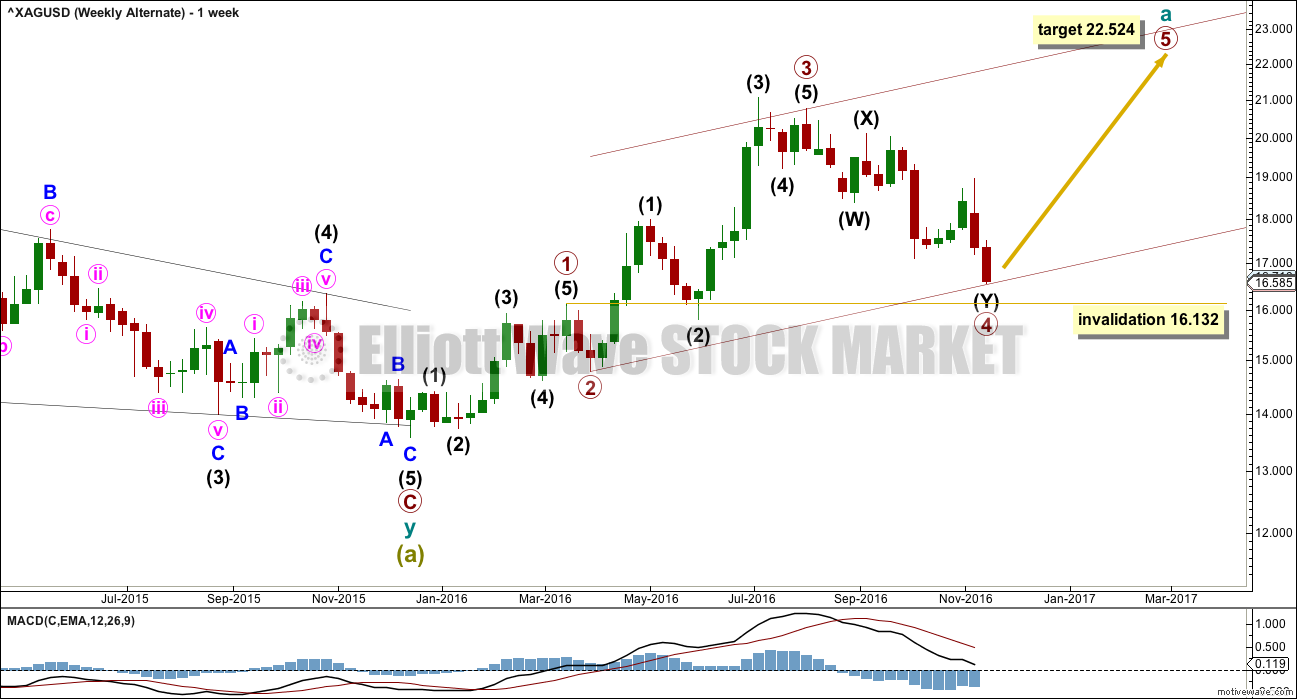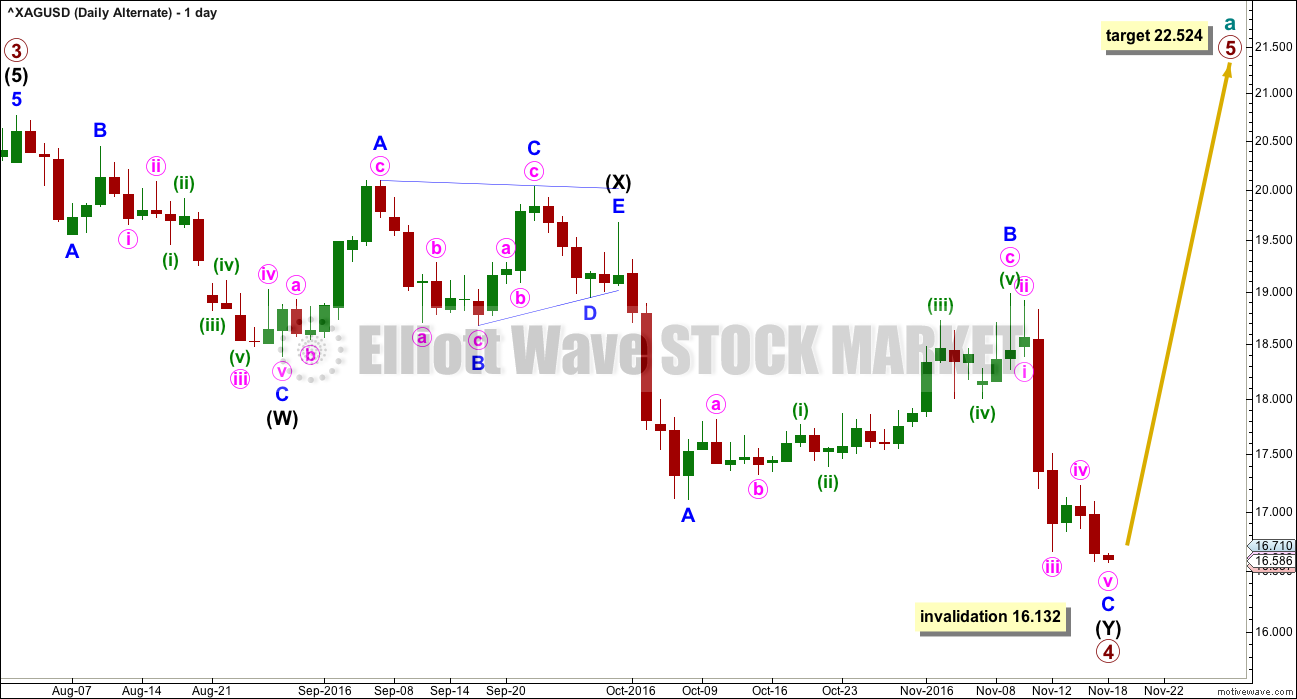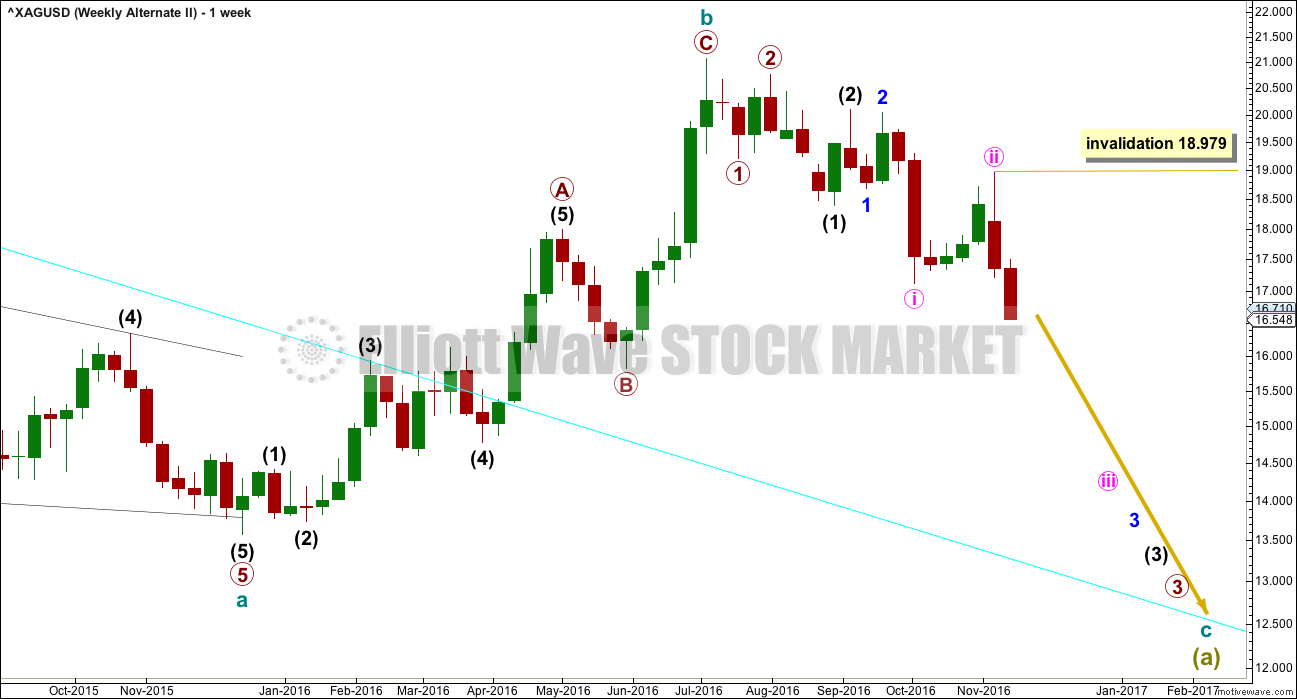Downwards movement over the last week invalidated the Elliott wave counts.
Summary: The bears are looking tired. There is a very little weakness to downwards movement, but not enough to call a low in place. It is possible that price may move lower.
New updates to this analysis are in bold.
To see how this analysis fits into the bigger picture, see last monthly charts here.
Main and alternate wave counts this week are presented in order of probability.
MAIN WEEKLY WAVE COUNT
Upwards movement fits better as a completed zigzag than it will as an incomplete five, at this stage. At the daily and weekly chart level, this wave count has a better fit and better look for Silver.
Primary wave X may have continued lower as a double zigzag.
Cycle wave b may be either a double zigzag or a double combination. If it is a double zigzag, then primary wave Y may be about equal in length with primary wave W, which would give a target at 24.03. As primary wave X is at this stage not very deep, it looks more like an X wave within a double zigzag.
If primary wave X continues lower, then this target must also move correspondingly lower.
X waves within combinations are more often very deep. There is no rule stating a maximum limit for an X wave. They may make new price extremes beyond the start of the correction.
MAIN DAILY WAVE COUNT
The structure of minor wave C may now be complete. This wave count expects a trend change either here or very soon indeed.
There is no Fibonacci ratio between minor waves A and C within intermediate wave (Y).
ALTERNATE WEEKLY WAVE COUNT
If a zigzag is unfolding upwards, then within it cycle wave a should subdivide as a five wave structure. So far primary waves 1 through to 4 may be complete.
If primary wave 4 continues lower, it may not move into primary wave 1 price territory below 16.132.
The disproportion between primary waves 2 and 4 reduces the probability of this wave count. Primary wave 2 lasted just two weeks. Primary wave 4 lasted 15 weeks.
The lack of alternation further reduces the probability of this wave count. Primary wave 2 is a single zigzag and primary wave 4 is a double zigzag.
ALTERNATE DAILY WAVE COUNT
Primary wave 3 ends with a truncation. This slightly reduces the probability of this wave count. A truncation may occur after a movement that is “too far, too fast”, which is a description that may fit the upwards wave labelled intermediate wave (3).
At 22.524 primary wave 5 would reach equality in length with primary wave 3. Both primary waves 3 and 5 would be extended. If this target is wrong, it may be too low. Primary wave 5 may end with a blowoff top and be a very strong swift extended wave.
Primary wave 4 may be over here or very soon indeed. It may not move into primary wave 1 price territory below 16.132.
SECOND ALTERNATE WEEKLY WAVE COUNT
It is also possible that cycle wave b is a complete zigzag and that downwards movement is the start of cycle wave c.
Unfortunately, because the main wave count has no lower invalidation point there can be no lower confirmation point for this alternate. Only structure would guide which wave count is more likely.
Within the middle of the third wave down, no second wave correction may move beyond the start of minute wave iii above 18.979. If this wave count is invalidated, then more confidence may be had in the first two wave counts.
It is judged that this alternate at this stage may be less likely. A series of overlapping first and second wave corrections ignores what looks like a triangle within this structure. Triangles may not be the sole corrective structure of a second wave.
Minute wave ii is much longer in duration than minor wave 2 and intermediate wave (2). The disproportion of this correction also reduces the probability of this wave count.
Technical weakness to current downwards movement is the main reason why this wave count is judged to be least likely.
If downwards movement continues and shows an increase in strength, then this wave count should be taken seriously. It is technically possible.
TECHNICAL ANALYSIS
WEEKLY CHART

Click chart to enlarge. Chart courtesy of StockCharts.com.
Last week completed a very strong downwards breakout on high volume. If this current week closes with lighter volume, then bears would be showing exhaustion.
On Balance Volume may be coming down to find support at an important trend line. This supports the first two Elliott wave counts.
There is still bullish divergence between the lower low for price and a higher low for RSI at the weekly chart level shown by orange lines. This supports the first two Elliot wave counts.
DAILY CHART
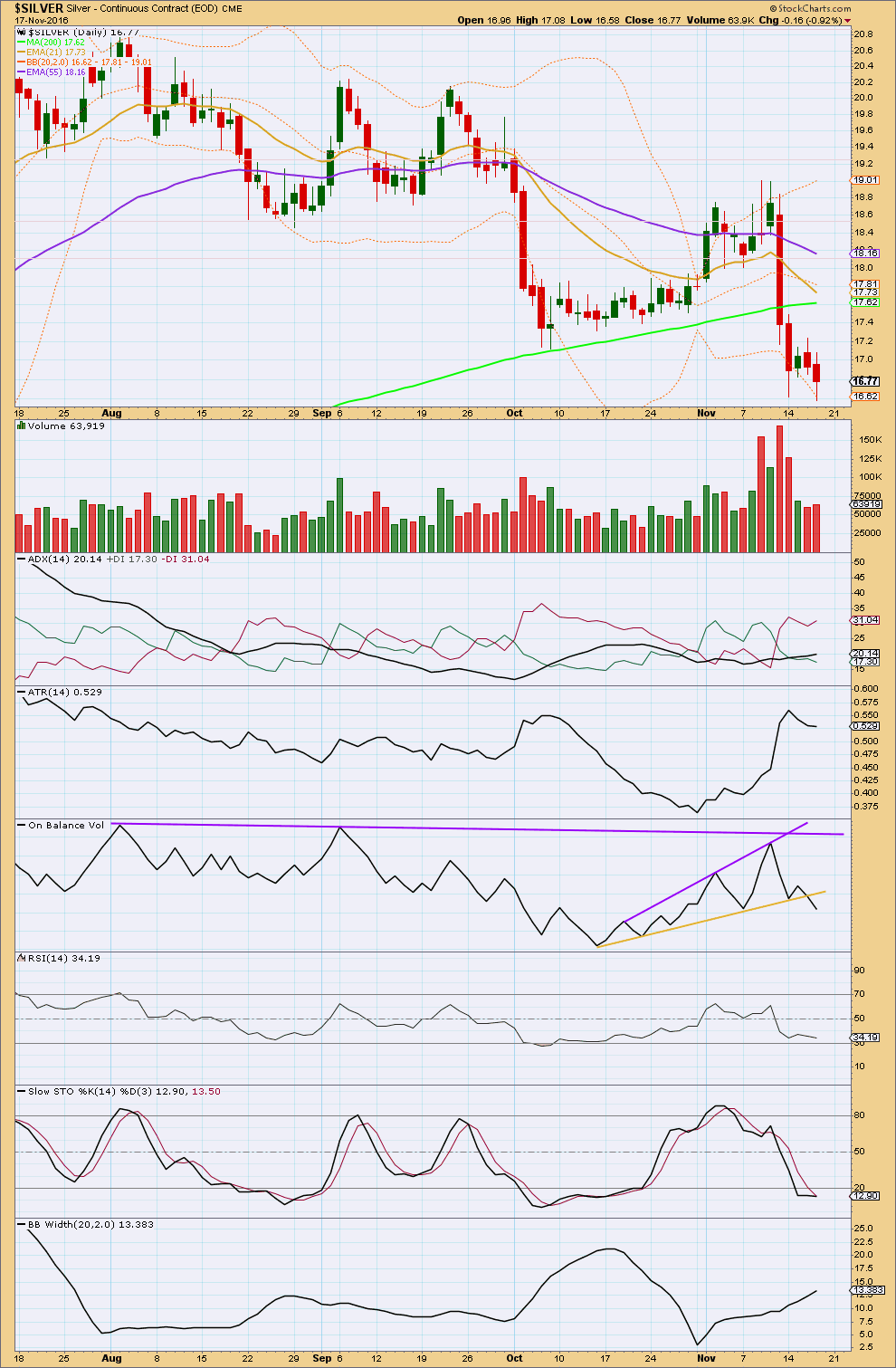
Click chart to enlarge. Chart courtesy of StockCharts.com.
The last two sessions of downwards movement come with lighter volume. Bears look tired. ATR is also declining, indicating a weakening trend.
ADX is still increasing, indicating a downwards trend. Bollinger Bands are widening in agreement.
With two of these three indicators suggesting a trend is in place, it should be assumed that a downwards trend is in place until proven otherwise.
On Balance Volume has breached the yellow support line giving a reasonable bearish signal.
The downwards trend and trend line breach from On Balance Volume support the second alternate Elliott wave count.
RSI is not extreme and does not exhibit divergence with price at the daily chart level to indicate short term weakness.
Stochastics is oversold and does exhibit some small divergence with price. This supports the first two Elliott wave counts.
Price is close to the lower edge of Bollinger Bands for two days now, so an upwards reaction would be reasonable to expect about here.
This analysis is published @ 04:10 a.m. EST.

